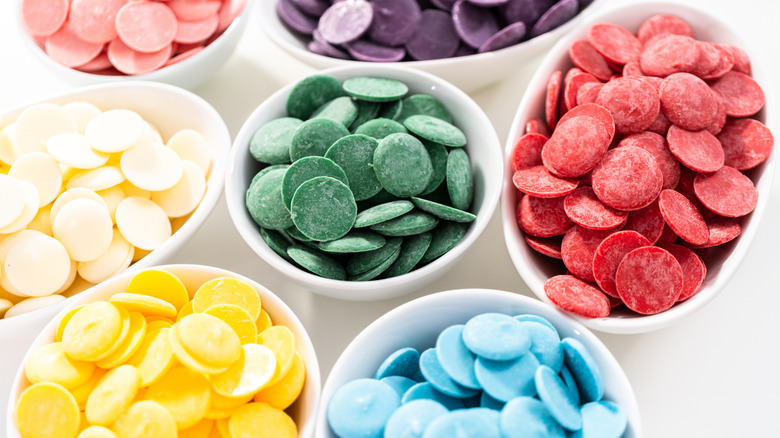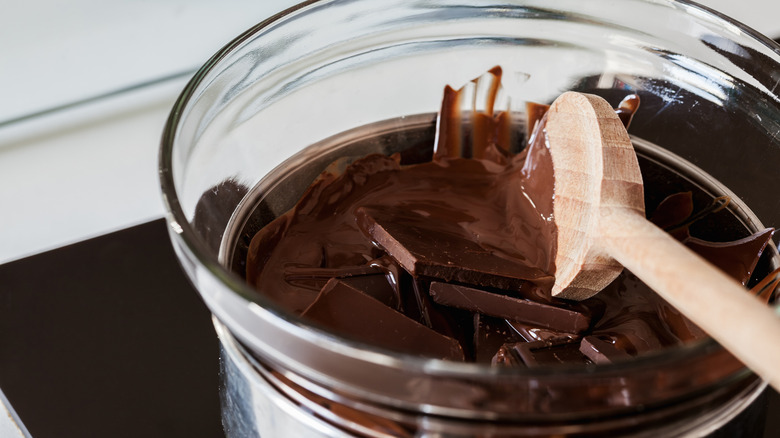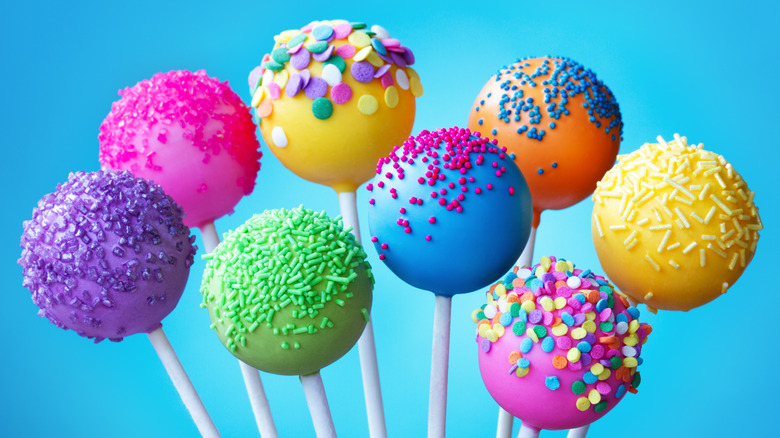Are Candy Melts Actually Chocolate?
All the types of baking chocolate have unique advantages, but a downside is that they mainly come in shades of white and brown. To make easy cake pops, dipped cookies, and rainbow fudge in any hue you can imagine, candy melts can come to the rescue. These colorful chips or wafers melt into a dippable consistency in seconds — but before you grab a bag, know that they're not an exact substitute for chocolate.
Candy melts have a solid texture when cool. They're sold in small pieces or chips and melt into a sweet coating that hardens into a shell, but that's where their resemblance to chocolate ends. They are not considered chocolate because they are made of sugar and oils, plus optional dairy ingredients and flavorings. These ingredients ensure the melts don't have to be tempered like chocolate but disqualify them from carrying the same name.
The standards for what qualifies as "chocolate" vary between countries and governing bodies, but it must be made from cacao seeds by definition. According to the U.S. Code of Federal Regulations, products labeled "chocolate" — whether white, milk, or dark (bittersweet-slash-semisweet) — must contain solids from cacao beans, such as cacao butter or chocolate liquor (aka ground cacao nibs). The Canadian government and the Food and Agriculture Organization of the United Nations also define chocolate as containing cacao butter and/or solids. Since candy melts normally don't contain these ingredients, they're out of the running. However, that doesn't mean they don't have their uses.
Differences between candy melts and chocolate in the kitchen
Candy melts behave very differently from chocolate, and they each have pros and cons. To achieve a crisp, smooth, glossy finish, chocolate must be tempered (heated within a controlled temperature range) to stabilize certain crystals in the cocoa butter. Otherwise, the shell on your chocolate-covered strawberries will be dull-looking, bendy, grainy, and quick to melt. The ideal type of chocolate for tempering is high-quality, high-fat couverture. The rub is that the process requires time and precision, often using a bain-marie or double boiler.
Since candy melts trade cacao fat for more stable oils, you can melt them via the microwave or stove with zero fuss. The two products differ further in taste and texture. Cacao solids give chocolate a rich mouthfeel and depth of flavor that candy melts lack. Since melts are primarily sugar, they may taste sweeter and more one-note. Oil gives them a more waxy texture. What they lack in complexity, they make up for in variety: Beyond plain or vanilla melts in countless colors, you can find flavors like strawberry, mint, peanut butter, and chocolate.
Your thoughts might be doing a detour here: "Chocolate candy melts? Do those still not count as chocolate?" Likely not. Chocolate-flavored melts may contain cocoa powder, but this makes them a "sweet cocoa and vegetable fat coating," according to the U.S. CFR. Even if oil-based melts contained some real chocolate, that would make them compound chocolate, which is still different from pure couverture.
When to use candy melts over chocolate, and vice-versa
Candy melts are by no means a worthless imitator that should never be chosen over chocolate. If you're a beginner baker, short on time or energy, or crafting colorful sweet treats together with kids, melts can be a great asset. Not only are they reliable and easy to work with, but they're a convenient, affordable alternative to buying every food coloring under the sun to dye real white chocolate. To make things even simpler, instead of buying a bag of melts for every color you need, purchase them in a range of primary colors and melt, mix, and match to get a variety of hues. Wilton, one of the leading brands of candy melts, even has a candy melts color chart to help you out.
Candy melts are especially good for small details. Turn them into a bright drizzle on your chocolate candies and ice cream bars, or stir them into a portion of classic vanilla buttercream for piping a cake, and they can go a long way without adding much of a distracting taste or texture. However, stay away from candy melts when making chocolate pretzels, two-ingredient chocolate truffles, ganache, or other recipes that require a rich, authentic chocolate flavor and a smooth, buttery texture. If you're worried about a recipe ending up too sweet, it's also best to pass on the sugar-loaded melts and spring for real chocolate instead.


